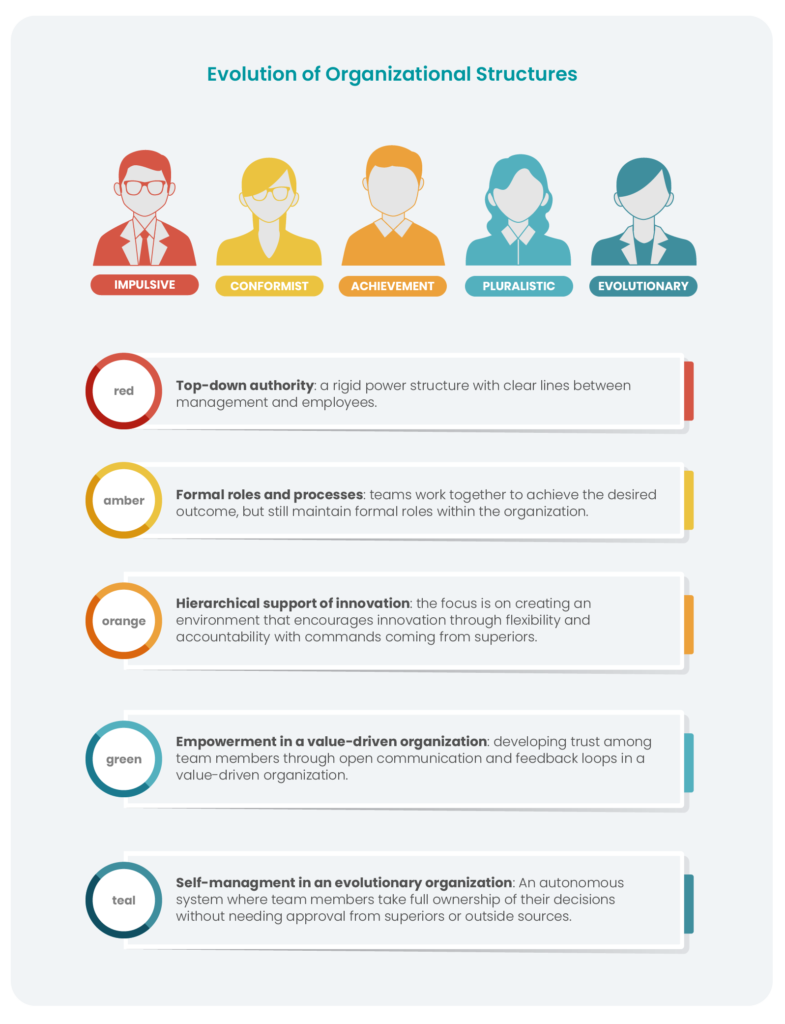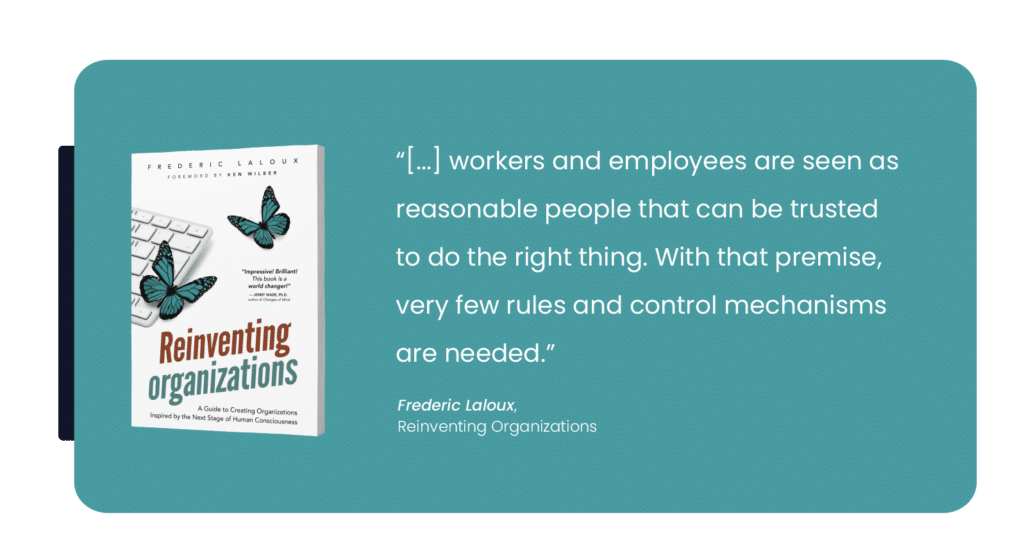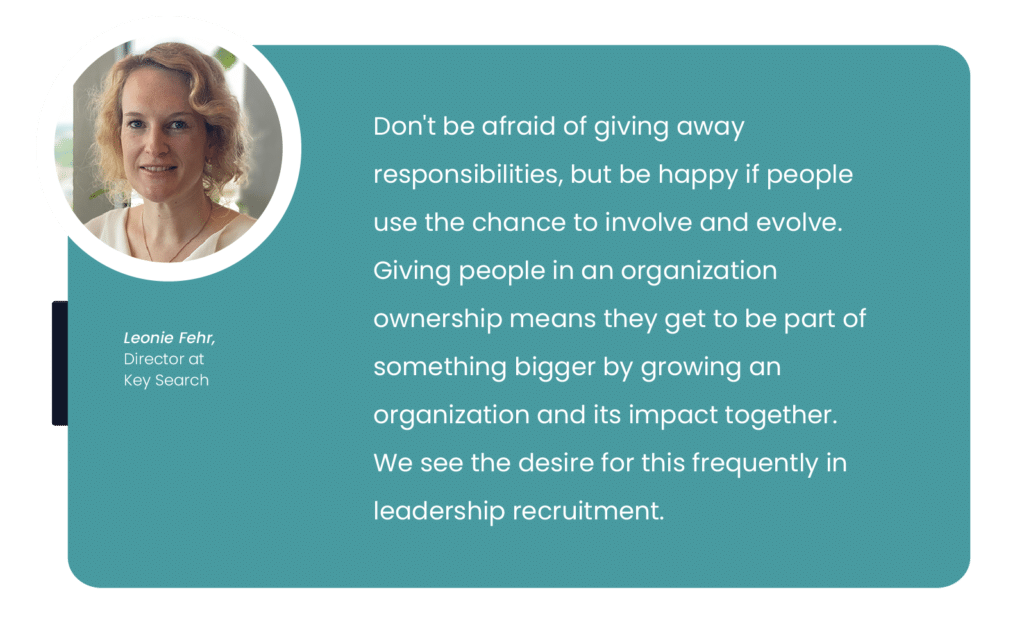In the last decade, the way organizations were run has changed drastically. As technology and customer needs to evolve, so do the ways we run organizations.
Over the past decade, teal organizations have been on the rise as an alternative to traditional organizational structures. We’ve seen a growing trend, but what is a teal organization? What makes it different from traditional organizational structures, what are the benefits, and what is next?
Contents
Definition and Benefits of Teal Organizations
Researched and named in his book Reinventing Organizations: An Illustrated Invitation to Join the Conversation on Next-Stage Organizations, Frederic Laloux introduces the concept of Teal Organizations as the fifth step in the evolution of the way businesses are run.
Organizational structures have evolved over time, from the traditional hierarchical systems of red and orange to the more modern teal structures. As organizations strive for greater collaboration, transparency, and autonomy in their operations, they are increasingly turning towards new organizational structures to facilitate the desired change.

A teal organization is a business model based on self-management and decentralized decision making, also known as a “holacratic” or “self-managed organization”.
Frederic Laloux, Reinventing Organizations
Benefits of Teal Organizations
Teal organizations emphasize employee empowerment. This means employees have the freedom to make their own decisions without having to refer back to management. Benefits at a glance are:
- reduced hierarchy
- increased transparency
- fostered collaboration
- increased self-management and ownership
- individual responsibility for decisions and actions

Why are Teal Organizations so impactful?
In teal organizations employees have the freedom to make their own decisions without having to refer back to management. This impacts the way they work, make decisions, and organize themselves outside of the traditional hierarchical structures.
In teal organizations, employees are not only encouraged but expected to take ownership of their work. This leads to each individual having more control over decisions that affect their job performance, which, in turn, leads to higher engagement levels among team members. The result is better team performance overall.
Because of these factors, teal organizations often see increased innovation since there is no hierarchy or bureaucracy slowing down progress. The teal model has achieved important breakthroughs that set it apart from previous organizational models.
Self-management in teal organizations:
Self-management refers to the ability of employees to make decisions and take action without the need for hierarchy, bureaucracy and micro-management. In teal organizations, effective operations are based on:
- Peer relationships
- High autonomy
- Accountability
Control and power are embedded horizontally and not tied to specific leadership positions in teal organizations. The importance of self-management lies in its ability to promote autonomy, creativity and innovation among employees.
Self-management enables holacracy in teal organizations. Holacracy refers to the replacement of traditional hierarchies with a distributed authority system that empowers employees to make decisions in a self-organized, autonomous way.
Trust in teal organizations:
Trust is a core element of teal organizations where team members are empowered and trusted to self-organize and collaborate. Trust enables teams to work towards a shared vision, purpose and goal, knowing that each team member will be fully committed to contributing to the shared goal and ultimately the teal company’s success.
Trust is essential to create an environment where team members feel safe to share ideas, be creative, participate and take risks without fearing judgment. This environment of trust leads to more diverse and creative solutions to challenges, which drives innovation.
Ultimately, trust is the foundation of a teal organization and is essential for it to succeed as it enables individuals to work together effectively, take risks and create innovative solutions that drive the organization forward.
Wholeness in teal organizations:
The environment of teal organizations invites people to fully express themselves beyond their “professional selves”, allowing for higher levels of drive, energy and creative problem solving.
Wholeness is a crucial element of teal organizations, where individuals are encouraged to bring their whole selves to work, including their emotions, values, and personal aspirations. In a teal organization, wholeness is important because it creates an environment where individuals can be authentic and express their unique perspectives, leading to more creativity, innovation, and engagement.
By valuing wholeness, organizations acknowledge that individuals are not just their roles, job titles, or skills, but multifaceted human beings with diverse experiences and emotions.
Evolutionary purpose in teal organizations:
This type of organization creates environments that use agile practices to sense and respond to needs, encourage collaboration, transparency and problem-solving to be innovative. Open communication between team members as well as feedback loops help build trust among the group.

The evolutionary purpose of teal organizations is to create a new paradigm of work that addresses the complex challenges of the 21st century. Teal organizations are based on the principles of self-management, wholeness, and evolutionary purpose, which enable them to adapt and thrive in an increasingly uncertain and rapidly changing world.
Teal Organizations vs Traditional Organizations
The main difference between teal organizations and traditional organizational structures and paradigms is in how decisions are made.
Traditional organizations rely heavily on top-down decision-making processes, while teal organizations focus on self-management and collaboration.
In addition, teal organizations often adopt technology solutions such as cloud computing, collaborative software tools and other innovative technology much earlier than traditional organizations to facilitate smooth, timely and location-independent communication and collaboration between teams and departments.
With their emphasis on collective decision-making, teal organizations strive for greater efficiency in operations while eliminating the need well-known in traditional organizational set ups to ask and wait for approval from superiors.
Finally, teal organizations tend to prioritize workplace wellness by providing flexible work schedules and locations and encouraging employees to take breaks when needed.
By shifting away from traditional hierarchical structures, teal organizations provide a platform for individuals to work together towards common goals without needing permission or approval from someone else.
“Think about it: should there be one decision maker at the top or a lot of decision makers in the field who know what the market and customers need because of the daily work they do?”
Leonie Fehr, Director at Key Search
Do you Know a Teal Organization?

is the essence of our business."
Key Search Values
The answer is yes. As a teal organization, the team at Key Search knows first hand how this blog article’s listed benefits of trust, self-management, wholeness, and the evolutionary purpose of teal organizations play out into measurable successes everyday. These undeniable benefits apply to any company wanting to travel the road of success in today’s digital era.
For businesses looking for ways to improve operations while also creating a positive environment for employees, making the switch to a teal organization can be the right choice. It’s important to note that transitioning from one structure to another requires careful planning -but if done correctly, it can result in measurable benefits for your business in terms of efficiency and employee satisfaction.
